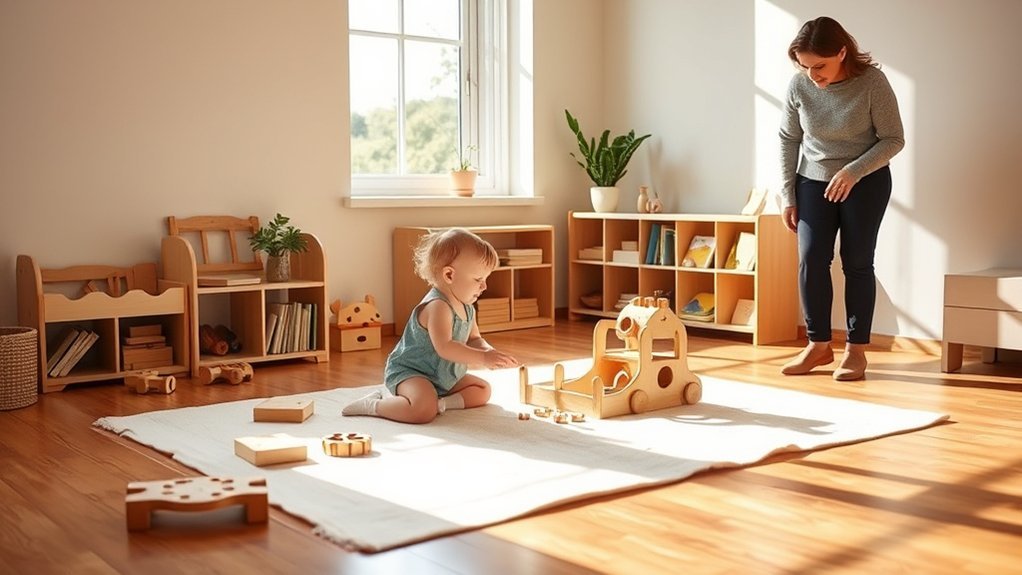Imagine your child enthusiastic about exploring a shelf filled with colorful, engaging materials, each one designed to spark curiosity and promote learning. To create a nurturing Montessori environment at home, you’ll need to focus on several key elements. By setting up a clutter-free space and thoughtfully selecting materials, you can foster independence and self-direction. But how do you guarantee that distractions are minimized and your child remains engaged? Let’s explore some practical strategies together.
Setting Up Your Montessori Space
When you’re creating a Montessori space at home, it’s essential to contemplate how your environment can foster independence and learning.
Begin by choosing a dedicated area that’s accessible and inviting. Keep furniture child-sized to promote comfort and autonomy. Arrange materials within reach, allowing your child to explore freely. Use natural lighting and calming colors to create a serene atmosphere.
Incorporate open shelving to display activities, encouraging them to select what interests them. Limit distractions by keeping the space organized and clutter-free.
Finally, include a few personal touches, like your child’s artwork, to make the environment feel special. By thoughtfully designing this space, you’re not just setting up a room; you’re cultivating a nurturing haven for growth and exploration.
Selecting Appropriate Materials
With your Montessori space thoughtfully arranged, the next step is selecting materials that enhance your child’s learning experience.
Focus on choosing open-ended, natural, and simple items that spark curiosity and creativity. Look for materials that align with their developmental stage, such as puzzles for problem-solving or art supplies for expression.
Choose open-ended, natural materials that inspire curiosity and creativity, matching them to your child’s developmental stage.
Consider incorporating everyday objects, like measuring cups or fabric scraps, to encourage exploration and practical life skills.
Prioritize quality over quantity; a few well-chosen materials can be more effective than a cluttered array.
Remember, your goal is to provide opportunities for hands-on learning, allowing your child to engage deeply with the materials.
Trust your instincts, and observe how your child interacts with them to make adjustments as needed.
Encouraging Independence and Self-Direction
To foster a sense of independence and self-direction in your child, it’s essential to create an environment that invites exploration and decision-making.
Start by providing materials that are accessible and age-appropriate, allowing your child to choose what to engage with. Encourage them to tackle tasks at their own pace, whether it’s dressing themselves or tidying up after play.
Offer guidance only when necessary, resisting the urge to intervene too early. Celebrate their efforts and successes, reinforcing their ability to make choices and solve problems.
Minimizing Distractions in the Learning Environment
Creating a learning environment that minimizes distractions is essential for fostering focus and engagement in your child.
Start by choosing a quiet space, away from TVs and loud noises. Keep the area organized and free from clutter, as a tidy environment helps reduce visual distractions. Use natural lighting whenever possible, and consider soft, calming colors to create a soothing atmosphere.
Choose a quiet, organized space with natural light and calming colors to minimize distractions and enhance focus.
Limit the number of toys or materials available during study time—too many options can overwhelm them. You might also establish a consistent routine, signaling when it’s time to learn.
Finally, encourage breaks between learning sessions; stepping away briefly can help refresh their mind and enhance concentration when they return.
Monitoring Progress and Adjusting Strategies
As you guide your child’s learning journey, regularly monitoring their progress is essential for understanding what works and what doesn’t. Take time to observe your child during activities, noting their engagement and challenges.
Keep a simple journal to track their achievements and areas needing support. This reflection helps you identify patterns and adjust your strategies accordingly.
If you notice your child struggling, consider modifying the materials or introducing new, stimulating resources that better fit their interests. Celebrate their successes, no matter how small, to build confidence and motivation.
Frequently Asked Questions
How Can I Adapt Montessori Principles for Younger Children?
You can adapt Montessori principles for younger children by creating a safe, organized environment with accessible materials. Encourage exploration, offer choices, and promote independence, allowing them to learn through hands-on experiences and discovery.
What Are Common Mistakes to Avoid in a Montessori Home?
You’ll want to avoid micromanaging your child’s activities, neglecting to prepare the environment, and dismissing their independence. Encourage exploration and trust their instincts; it fosters confidence and a love for learning in your Montessori home.
How Do I Handle Resistance to Independent Learning?
When you face resistance to independent learning, stay patient and supportive. Offer choices, break tasks into smaller steps, and celebrate small successes. Encourage curiosity and exploration, making learning enjoyable rather than a chore.
Can I Incorporate Screen Time in a Montessori Environment?
Absolutely, you can incorporate screen time in a Montessori environment. Just guarantee it’s purposeful, engaging, and complements hands-on activities. Balance is key, so prioritize interactive content that encourages creativity and independent thinking while limiting passive consumption.
What Role Do Siblings Play in Montessori Learning at Home?
Siblings play an essential role in Montessori learning at home. They encourage collaboration, share knowledge, and foster independence. You can create opportunities for them to work together, enhancing social skills and strengthening family bonds through shared experiences.
Conclusion
Creating a Montessori environment at home is like nurturing a delicate garden; with the right setup, your child can bloom into their fullest potential. By thoughtfully arranging their space, selecting engaging materials, and promoting independence, you’re fostering a rich soil for growth. Keep distractions at bay, and be attentive to their needs. With patience and a little flexibility, you’ll watch them flourish in their learning journey, cultivating curiosity and confidence every step of the way.
